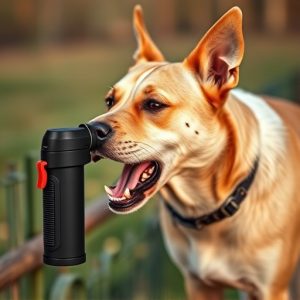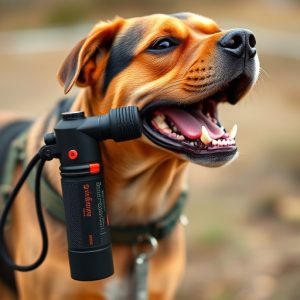Neutralizing Dog Spray: Response, Wash, Prevention & Treatment
Dog spray, using capsaicin from chili peppers, irritates and disorients aggressive dogs. Upon exposu…….
Dog spray, using capsaicin from chili peppers, irritates and disorients aggressive dogs. Upon exposure, quickly remove contaminated clothing, rinse with water, and gently cleanse with mild soap to neutralize capsaicin. In a confrontation, maintain calmness, back away slowly, and flush skin with cold water. For affected areas, rinse with water for 15 minutes or use mild soap/baby shampoo. Recognize irritant symptoms, soothe irritation with calming lotion; severe cases need medical attention. Proactively protect by avoiding high-risk areas, understanding pet laws, using positive reinforcement training, and staying alert. Interpret canine body language to anticipate attacks, quickly neutralize spray with water or neutralizing wipes.
“Staying safe while outdoors should be a priority, especially with the presence of dogs, which can quickly turn a pleasant walk into a terrifying experience. Dog spray, or mace, is a common defense tool, but understanding its composition and immediate response strategies is crucial for neutralizing its effects effectively. This guide delves into the specifics of dog spray, offering solutions for neutralizing it on pet skin, recognizing medical needs, and implementing prevention strategies to ensure your safety and peace of mind.”
- Understanding Dog Spray: Composition and Effect
- Immediate Response: What to Do When Targeted
- Neutralizing the Spray: Effective Wash Techniques
- Medical Attention: Recognizing and Treating Irritations
- Prevention Strategies: Avoidance and Training Tips
Understanding Dog Spray: Composition and Effect
Dog spray, also known as mace spray for pets, is a specialized self-defense tool designed to deter aggressive dogs. Understanding its composition and effects is crucial when aiming to neutralize it on pet skin. Typically, dog spray contains capsaicin, the same compound found in chili peppers, which irritates a dog’s eyes, nose, and throat, temporarily disorienting them. This non-lethal spray is designed to be safe for humans but effective at calming or distracting an attacking dog.
When your pet comes into contact with dog spray, it’s essential to act swiftly. Remove any contaminated clothing or accessories to prevent further exposure. Rinse the affected area thoroughly with water and gently cleanse the skin using a mild, fragrance-free soap. This process helps to neutralize the capsaicin, ensuring minimal discomfort for your pet. Proper handling of dog spray exposure can make all the difference in managing potential irritation and promoting faster recovery.
Immediate Response: What to Do When Targeted
If you find yourself facing a dog that’s spraying you with mace, your immediate reaction is crucial. The first step is to stay calm and avoid panicking; this will help you think clearly and make rational decisions. Don’t turn away or run, as dogs may interpret this as a sign of weakness or prey. Instead, back away slowly while keeping an eye on the dog’s movements.
Once you’re at a safe distance, quickly assess the situation. If the mace is on your skin, don’t rub it in or try to wash it off immediately. This can cause the irritant to spread further. Instead, use a cold water hose or wet cloth to gently flush the area, ensuring you remove all visible signs of the spray. Neutralizing mace spray on pet skin requires patience and careful action to prevent further irritation or damage.
Neutralizing the Spray: Effective Wash Techniques
When confronted with a dog’s spray, quick and effective action is crucial to neutralize the irritant. The first step is to quickly wash the affected area with copious amounts of water. This helps to dilute and disperse the chemical agent, reducing its potency. Use a gentle hand to avoid further irritation while ensuring thorough cleansing.
For sensitive areas like the eyes and face, rinse with water for at least 15 minutes. For skin contact, lather up mild soap or baby shampoo and continue rinsing until all residue is removed. This process neutralizes Mace spray on pet skin, alleviating discomfort and preventing potential damage.
Medical Attention: Recognizing and Treating Irritations
When facing dog spray, whether it’s from a neutralizing mace or any other irritant, the first step in self-defense is to quickly assess and address the situation. If the spray makes contact with your skin, it’s crucial to recognize the symptoms of irritation as soon as possible. This can include redness, itching, stinging, or burning sensations.
To neutralize the Mace spray on pet skin (or human skin for that matter), gently wash the affected area with mild soap and plenty of cool water. Apply a calming lotion or cream to soothe itching and reduce inflammation. If irritation persists or becomes severe, seek medical attention immediately. A healthcare professional can provide guidance on treating the symptoms and recommend appropriate follow-up care.
Prevention Strategies: Avoidance and Training Tips
Preventing encounters with dogs that may be carrying spray is a proactive approach to self-defense. One of the best strategies is to avoid potential hazards, such as areas known for dog activity or those with loose pet regulations. By understanding and respecting local laws regarding pets, you can minimize risks. Additionally, training your own dog or ensuring they are well-behaved and trained can go a long way in preventing aggressive situations. Positive reinforcement methods teach dogs good manners and reduce the likelihood of them resorting to spray as a first response.
When out in public spaces, stay alert and aware of your surroundings. If you see a dog displaying defensive behavior or barking aggressively, give it space and avoid direct eye contact, which can be perceived as a threat. Keep your distance and do not corner the animal, as this may trigger a protective response. Learning to read canine body language can help you anticipate potential attacks and take appropriate evasive actions. If a dog does release spray, quickly remove any exposed skin from the area to neutralize the chemical, especially on sensitive areas like eyes and nose, using water or neutralizing wipes if available.
Understanding how to neutralize dog spray is an essential skill for anyone interacting with canines, especially in situations where self-defense might be required. By quickly recognizing the composition and effects of dog spray, you can take immediate action to protect yourself and properly wash away the irritant. With the right techniques, such as using a powerful stream of water or specific neutralizing solutions, it’s possible to minimize discomfort and prevent long-term skin irritation. Remember, prevention is key; regular training and following safety protocols can significantly reduce the risk of exposure to dog spray.


